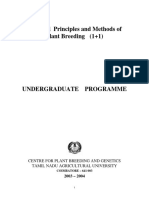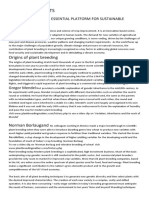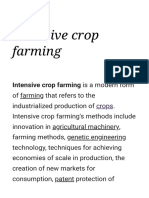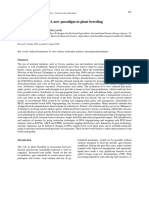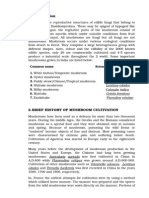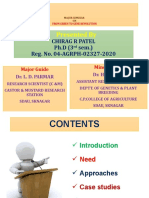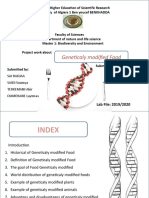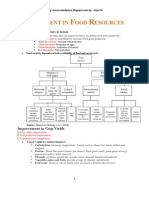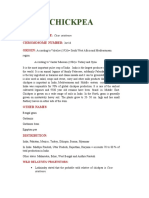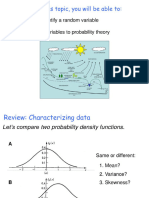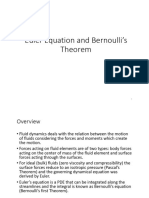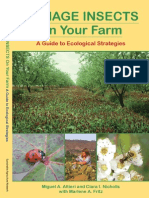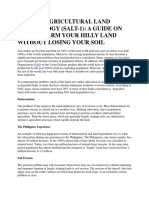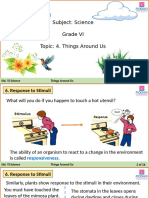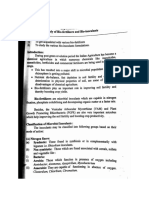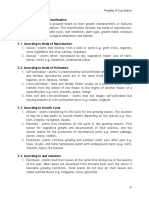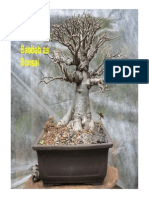Lec 01
Lec 01
Uploaded by
AbhishekCopyright:
Available Formats
Lec 01
Lec 01
Uploaded by
AbhishekOriginal Title
Copyright
Available Formats
Share this document
Did you find this document useful?
Is this content inappropriate?
Copyright:
Available Formats
Lec 01
Lec 01
Uploaded by
AbhishekCopyright:
Available Formats
01.
Aims and objectives of Plant Breeding
Plant breeding is an art and science, which tells us ways and means to change the genetic
architecture of plants so as to attain a particular objective. Plant breeding can be accomplished
through many different techniques ranging from simply selecting plants with desirable
characteristics for propagation, to more complex molecular techniques Plant breeding has been
practiced for thousands of years, since near the beginning of human civilization. It is now
practiced worldwide by individuals such as gardeners and farmers, or by professional plant
breeders employed by organizations such as government institutions, universities, crop-specific
industry associations or research centers.
International development agencies believe that breeding new crops is important for
ensuring food security by developing new varieties that are higher-yielding, resistant to pests and
diseases, drought-resistant or regionally adapted to different environments and growing
conditions.
The objectives may be
a) Crop improvement
b) Improved agronomic characters
c) Resistance against biotic and abiotic stress
1. Increased yield
Majority of our breeding programmes aims at increased yield. This is achieved by
developing more efficient genotypes. The classical examples are utilization of Dee Gee Woo
Gen in rice and Norin10 in wheat. Identification and utilization of male sterility
2. Improving the quality
Rice -milling, cooking quality, aroma and grain colour
wheat- milling and baking quality and gluten content.
pulses -Protein content and improving sulphur containing amino acids
oilseeds- PUFA content
3. Elimination of toxic substance
HCN content in jowar plants
Lathyrogen content in Lathyrus sativus (βN oxalyamine alanine BOAA)
Erucic acid in Brassicas
Cucurbitacin in cucurbits
4. Resistance against biotic and abiotic stresses
Biotic stress: Evolving pests and diseases resistant varieties there by reducing cost of
cultivation, environmental pollution and saving beneficial insects.
Abiotic stress: It is location specific problem. Soil factors and edaphic factors some times
poses severe problems. Breeding resistant varieties is the easy way to combat abiotic
stress.
5. Change in maturity duration – Evolution of early maturing varieties
6. Improved agronomic characters -Production of more tillers – E.g. Rice, Bajra,
7. Reducing the plant height to prevent lodging – Rice
8. Photoinsensitivity – Redgram, sorghum
9. Non-shattering nature – Green gram, Brassicas
10. Synchronized maturity – Pulses
11. Determinate Growth habit –determinate growth – Pulses
12. Elimination or introduction of dormancy –Groundnut
Scope of plant breeding
Since the cultivable land is shrinking and there is no scope for increasing the area under
cultivation, the only solution to meet the food requirement is by increasing the crop yield through
genetic improvement of crop plants. There are two ways by which yield improvement is
possible.
1. Enhancing the productivity of crops
This can be done
a) By the proper management of soil and crops involving suitable agronomic practices and
harvesting physical resources.
b) By using high potential crop varieties created by appropriate genetic manipulation of
crop plants.
2. Stabilizing the productivity achieved
This is done by using crop varieties that are bred especially for wide adaptation or for
specific crop zones to offset the ill effects of unfavorable environmental conditions prevailing in
the areas.
Plant breeding, the past, present and future scopes
Indian agriculture remained stagnant particularly during early sixties. Long spells of
severe drought and serious out break of disease in some parts of the country led some
futurologists to state that a possible doom in India by the end of the decade. However, we
achieved break through in crops such as rice, wheat, pearlmilelt, jowar and maize.
The indica x japonica cross derivative ADT 27 is the first high yielding rice of Tamil
Nadu. The identification of Dee Gee Woo Gen and release of Wonder rice IR 8 (peta x DGWG)
changed the scenario from poverty to problem of plenty.Like wide identification of dwarfing
gene in Japanese wheat variety Norin-10 by Borlaug and breeding of Mexican dwarf wheat
varieties led to the release of wheat varieties life Kalyan sona in India.
In pearl millet, breeding by male sterile line Tift 23A at Tifton, Georgia by Burton and
his coworker and later on its introduction to India led the release of hybrid bajra HB1 to HB4,
which increased bajra production many fold. In Jowar, breeding of first male sterile line
combined kafir 60A and its introduction into India led to the release of first hybrid sorghum CSH
1 (CK 60A x IS 84) during 1970s.
At present we are in search of alternate source of cytoplasm in almost all crops to breed
hybrids with new source of cytoplasm to prevent the possibility of appearance of new pest and
diseases. Thus, the future of plant breeding is a challenging task. The deployment of innovative
breeding techniques will be a new tool to assist the conventional breeding techniques.
Undesirable effects of Plant Breeding
1. Genetic erosion: Disappearance of land races due to introduction of high yielding varieties.
Eg. Introduction of IR 20 rice led to disappearance of land races of samba rice.
2. Narrow genetic base: Genetic vulnerability to pest and diseases.
Tift 23A - Bajra - Susceptible downy mildew
T cytoplasm - Maize - susceptible to Helminthosporium
3. Minor disease and pest become major due to intensive resistance breeding
RTV (Rice Tungro Virus)
Grey mold in Bengalgram
4. Attainment of yield plateau: No more further increase in yield.
History of Plant Breeding
It started when man first chose certain plants for cultivation. There is no recorded history
when the plant breeding started.
As early as 700 BC Babylonians and Assyrians artificially pollinated the date palm.
In 1717 Thomas Fairchild produced the first artificial hybrid.
Joseph Kolreuter, a German made extensive crosses in Tobacco and Solanum between
1760 and 1866 and studied the progenies in detail.
Thomas Andrew Knight (1759-1835) was the first man to produce several new fruit
varieties by using artificial hybridization.
Le Coutier, a farmer published his results on selection in wheat in the year 1843. He
concluded that progenies from single plants were more uniform.
Patrick Shireff a Scotsman practiced individual plant selection in wheat and oats and
developed some valuable varieties.
Vilmorin (1857) proposed individual plant selection based on progeny testing. This was
known as “Vilmorins principle of progeny testing’. He proposed this progeny testing in
sugar content in sugar beets (Beta vulgaris). But this method was ineffective in wheat.
This clearly demonstrated the difference between effect of selection in cross and self-
pollinated crops.
Nilsson and his associates in Sweedish Seed Association, Svalof Sweeden (1890) refined
the single plant selection.
In 1903 Johansen proposed the famous ‘pure line theory’ which states that a pure line is
progeny of a single self fertilized homozygous plant. He proposed this theory based on
his studies in Phaseolus vulgaris.
G.H. Shull work in maize is the forerunner for the present day hybrid maize programme.
He described in detail about the effect of inbreeding.
During 1960’s Norman Borlaug, the Nobel laureate developed Mexican semi dwarf
wheat varieties, which paved the way for green revolution in wheat. The dwarfing gene
was isolated from wheat variety Norin 10. Later on this Mexican dwarf were introduced
in the India by Dr. M.S.Swaminathan and a number of high yielding wheat varieties like
Kalyan Sona, Sharbathi Sonara were developed.
In rice the identification of dwarf Dee Gee Woo Gen from a tall rice variety by a Taiwan
farmer revolutionized rice breeding. Using this DGWG at IRRI during 1965 the wonder
rice IR 8 was released.
Nobilisation in sugarcane by C.a. Barber and T.S.Venkataraman is another monumental
work in plant breeding.
You might also like
- Intro Plant BreedDocument28 pagesIntro Plant BreedFirdose Kolar100% (1)
- Nymphaea Ampla - Maya Ethnobotany Field ResearchDocument17 pagesNymphaea Ampla - Maya Ethnobotany Field ResearchEROCx1No ratings yet
- PBG 301 First Half NotesDocument79 pagesPBG 301 First Half NotesUnknownAuthorNo ratings yet
- PBG 301 Complete.Document186 pagesPBG 301 Complete.UnknownAuthorNo ratings yet
- Principles of BreedingDocument114 pagesPrinciples of BreedingSovit PatnaikNo ratings yet
- Principles of Plant BreedingDocument199 pagesPrinciples of Plant Breedingcompanyfile1990No ratings yet
- All Combined Gpb201Document741 pagesAll Combined Gpb201Abhinav K GNo ratings yet
- Fundamentals of Plant Breeding AGS127 PDFDocument92 pagesFundamentals of Plant Breeding AGS127 PDFNikhil SherawatNo ratings yet
- Bio 309 - 0Document63 pagesBio 309 - 0okiprotich0No ratings yet
- Conventional Methods of Crop ImprovementDocument20 pagesConventional Methods of Crop Improvementrajiv pathakNo ratings yet
- Rice Breeding: Past, Present and Future: (IRRI)Document22 pagesRice Breeding: Past, Present and Future: (IRRI)AtifNaeemNo ratings yet
- Plant Breeding 2023 Batch MaterialDocument68 pagesPlant Breeding 2023 Batch Materialankitabehera1280No ratings yet
- 01 - Objectives of Plant BreedingDocument6 pages01 - Objectives of Plant BreedingVoice AnonymousNo ratings yet
- Breeding HandoutDocument93 pagesBreeding Handouthdereje59No ratings yet
- PLANT BREEDING - INTRO-2nd Lecture, 2003Document22 pagesPLANT BREEDING - INTRO-2nd Lecture, 2003lkokodkodNo ratings yet
- Breeding and BiotechnologyDocument29 pagesBreeding and Biotechnology8D cibi chakrawarthyNo ratings yet
- RggateDocument8 pagesRggatenomanalipk345No ratings yet
- Modern Agriculture: Module - 6Document16 pagesModern Agriculture: Module - 6clarincelouigenotivaNo ratings yet
- GPB 211 (2)Document37 pagesGPB 211 (2)rohitmaurya2032002No ratings yet
- GPB-232 SCOA, JainapurDocument123 pagesGPB-232 SCOA, JainapurKaran NNo ratings yet
- Seeds of SuicideDocument159 pagesSeeds of Suicideramkumaran100% (2)
- Agricultural BiotechnologyDocument40 pagesAgricultural BiotechnologyMateoTabaresNo ratings yet
- LC1 Presentation 04042020082630domestication of Crop Plants PDFDocument137 pagesLC1 Presentation 04042020082630domestication of Crop Plants PDFKarka AkademyNo ratings yet
- Agricultural Arts NotesDocument15 pagesAgricultural Arts NotesjovelNo ratings yet
- Intensive Crop Farming - WikipediaDocument29 pagesIntensive Crop Farming - WikipediaBashiir NuurNo ratings yet
- Strategies for Enhancement in Food Production _ Short NotesDocument1 pageStrategies for Enhancement in Food Production _ Short NotesshrnvrxmpnNo ratings yet
- Principle of Plant Breeding HortiDocument127 pagesPrinciple of Plant Breeding HortikellonNo ratings yet
- Strategies for Enhancement in Food Production _ MindmapsDocument3 pagesStrategies for Enhancement in Food Production _ MindmapsshrnvrxmpnNo ratings yet
- Mass SelectionDocument123 pagesMass SelectionYosef AndualemNo ratings yet
- CBSE Class 9 Biology Improvement in Food ResourcesDocument13 pagesCBSE Class 9 Biology Improvement in Food ResourcesChander Bhan SharmaNo ratings yet
- You Too Can Be A Seed Saver! A Guide To Seed SavingDocument11 pagesYou Too Can Be A Seed Saver! A Guide To Seed SavingdeepaksolarNo ratings yet
- BIO2 11_12 Q3 0203 PF FDDocument77 pagesBIO2 11_12 Q3 0203 PF FDTAWAGUEN LHERMANo ratings yet
- Group3.-Narrative 2Document18 pagesGroup3.-Narrative 2Jaspher HernandezNo ratings yet
- Class 9 Science Chapter 15 Revision Notes BESTUM..Document5 pagesClass 9 Science Chapter 15 Revision Notes BESTUM..Rohinish DeyNo ratings yet
- Induced MutationDocument8 pagesInduced MutationJohn ZNo ratings yet
- Edodes and Tremella Fuciformis Was First Recorded in China in The YearsDocument23 pagesEdodes and Tremella Fuciformis Was First Recorded in China in The YearsSamuel DavisNo ratings yet
- Summary Notes For Introduction To Crop ProductionDocument17 pagesSummary Notes For Introduction To Crop ProductionRachael ThomasNo ratings yet
- Biotech in AgricultureDocument24 pagesBiotech in Agricultureayushmahawar2708No ratings yet
- 164010120 Improvement in Food ResourcesDocument11 pages164010120 Improvement in Food Resourcesrajavegetable1982No ratings yet
- Presented By: Chirag R Patel PH.D (3 Sem.) Reg. No. 04-AGRPH-02327-2020Document35 pagesPresented By: Chirag R Patel PH.D (3 Sem.) Reg. No. 04-AGRPH-02327-2020Chirag PatelNo ratings yet
- Green RevolutionDocument49 pagesGreen RevolutionJopie ArandaNo ratings yet
- Chapter 1Document26 pagesChapter 1trendingallthings1No ratings yet
- Restoring Heritage Grains - Chapter 1: On The Verge of ExtinctionDocument16 pagesRestoring Heritage Grains - Chapter 1: On The Verge of ExtinctionChelsea Green Publishing100% (1)
- CH 11 Enhancement of Food ProductionDocument8 pagesCH 11 Enhancement of Food Productionyashrajthorat2834No ratings yet
- Généticaly Modified FoodsDocument32 pagesGénéticaly Modified Foodssoumya lidiliNo ratings yet
- Improvement in Food ResourcesDocument11 pagesImprovement in Food Resourcesanjupal100% (2)
- Project Report On Organic Farming of Millets, Dairy and Vermiculite/vermicultureDocument10 pagesProject Report On Organic Farming of Millets, Dairy and Vermiculite/vermicultureEIRI Board of Consultants and PublishersNo ratings yet
- What Is Genetically Modified FoodDocument13 pagesWhat Is Genetically Modified FoodPraveen KumarNo ratings yet
- 09 Science Notes Ch15 Improvement in Food ResourcesDocument12 pages09 Science Notes Ch15 Improvement in Food ResourcesDhiraj GuptaNo ratings yet
- 10. Conservation Meets Innovation- Pre-Breeding With Crop Wild Relatives for Future-Proof CropsDocument3 pages10. Conservation Meets Innovation- Pre-Breeding With Crop Wild Relatives for Future-Proof Cropsمحمد صالح عامر ذمرانNo ratings yet
- Agriculture Basics pdf1692329016963Document11 pagesAgriculture Basics pdf1692329016963lokeshkumarsimma025No ratings yet
- Plant Breeding of F1 Seeds Farro&DacanayDocument3 pagesPlant Breeding of F1 Seeds Farro&DacanayJevelyn Mendoza FarroNo ratings yet
- Improvement in Food Resources-NotesDocument9 pagesImprovement in Food Resources-Notesapi-285274293No ratings yet
- CHAPTER 1-3 (1)Document19 pagesCHAPTER 1-3 (1)Fortune VusheNo ratings yet
- Plant Breeding SHEETDocument16 pagesPlant Breeding SHEETaiimsonian025No ratings yet
- Chickpea: Scientific Name: Chromosome Number OriginDocument29 pagesChickpea: Scientific Name: Chromosome Number Originashes kumar jenaNo ratings yet
- Crop Production Technology-I (Kharif Crops)Document60 pagesCrop Production Technology-I (Kharif Crops)ravidharu6No ratings yet
- Modern Biotechnology and AgricultureDocument5 pagesModern Biotechnology and AgricultureCiePol15No ratings yet
- Commercial Horticulture - With Chapters on Vegetable Production and Commercial Fruit GrowingFrom EverandCommercial Horticulture - With Chapters on Vegetable Production and Commercial Fruit GrowingNo ratings yet
- Lec 08Document3 pagesLec 08AbhishekNo ratings yet
- No - Ntnu Inspera 2548494Document72 pagesNo - Ntnu Inspera 2548494AbhishekNo ratings yet
- Baf e Drop Structure Design Relationships: Journal of Hydraulic Engineering September 2013Document9 pagesBaf e Drop Structure Design Relationships: Journal of Hydraulic Engineering September 2013AbhishekNo ratings yet
- Lec 19 SkelDocument24 pagesLec 19 SkelAbhishekNo ratings yet
- Probable LejklajDocument75 pagesProbable LejklajAbhishekNo ratings yet
- PreviewpdfDocument372 pagesPreviewpdfAbhishek0% (1)
- NumericalDocument14 pagesNumericalAbhishekNo ratings yet
- ProbabilityDocument37 pagesProbabilityAbhishekNo ratings yet
- Editorial For The Special Edition On Global Precipitation Measurement (GPM) : 5th AnniversaryDocument4 pagesEditorial For The Special Edition On Global Precipitation Measurement (GPM) : 5th AnniversaryAbhishekNo ratings yet
- Euler Equation and Bernoulli's Theorem - 1 Slide Per PageDocument45 pagesEuler Equation and Bernoulli's Theorem - 1 Slide Per PageAbhishekNo ratings yet
- Adminjtir, Journal Manager, Article08Document6 pagesAdminjtir, Journal Manager, Article08AbhishekNo ratings yet
- Dry, Wet and Dew Point TemperaturesDocument2 pagesDry, Wet and Dew Point TemperaturesAbhishekNo ratings yet
- UPPSC 2017 Vol. 2Document35 pagesUPPSC 2017 Vol. 2AbhishekNo ratings yet
- Commercial Cultivation of JasmineDocument19 pagesCommercial Cultivation of Jasminemohdkamran1No ratings yet
- Manage Insects On Your FarmDocument130 pagesManage Insects On Your FarmJDaniel Cornu100% (1)
- Sloping Agricultural Land TechnologyDocument12 pagesSloping Agricultural Land TechnologyBe ChahNo ratings yet
- Wood Anatomy Sem-2 VishwaDocument18 pagesWood Anatomy Sem-2 Vishwameet ChaudharyNo ratings yet
- Keragaman Fenotipe Dan Produktivitas Labu Kuning Nusantara (Dutchene) DALAM Rangka Pengembangan Varietas UnggulDocument6 pagesKeragaman Fenotipe Dan Produktivitas Labu Kuning Nusantara (Dutchene) DALAM Rangka Pengembangan Varietas UnggulArni TaloimNo ratings yet
- Project: Development of P9 Sector E-25 Hotel, Residential & Commerical Complex (SITE NO 278)Document9 pagesProject: Development of P9 Sector E-25 Hotel, Residential & Commerical Complex (SITE NO 278)bhupsjangirNo ratings yet
- Drawing Aussie Flora: Australian National Botanic GardensDocument16 pagesDrawing Aussie Flora: Australian National Botanic GardensAna SantosNo ratings yet
- Asexual Reproduction in PlantsDocument4 pagesAsexual Reproduction in Plantseasylearning83No ratings yet
- PPT3_CB_VI_Sci_Things Around UsDocument16 pagesPPT3_CB_VI_Sci_Things Around UsdizaguptaNo ratings yet
- Organic Farming Practical Semester 2-1Document16 pagesOrganic Farming Practical Semester 2-1Khushi RaniNo ratings yet
- Horticulture Question BankDocument3 pagesHorticulture Question BankVivek Ponnusamy100% (4)
- Farming Data in Project ZomboidDocument3 pagesFarming Data in Project ZomboidKevin Sibley100% (1)
- Terrestrial Biome Cheat SheetDocument1 pageTerrestrial Biome Cheat SheetVvi MedinaNo ratings yet
- CpSci 101 - Module 5 - Lesson 3 and 4 Descriptive Classification & Agricultural ClasiificationDocument8 pagesCpSci 101 - Module 5 - Lesson 3 and 4 Descriptive Classification & Agricultural ClasiificationRegan Roldan RolaNo ratings yet
- FEBACEAEDocument14 pagesFEBACEAEchp8615742No ratings yet
- Kingdom Plantae: Botany - The Study of PlantsDocument26 pagesKingdom Plantae: Botany - The Study of PlantsEric cruzNo ratings yet
- No. Company Name Address City Region/Land ZIPDocument4 pagesNo. Company Name Address City Region/Land ZIPmohammad hasan seifdarNo ratings yet
- Reproduction and Development LAB EXERCISEDocument6 pagesReproduction and Development LAB EXERCISESophie BaromanNo ratings yet
- September 2024 AvailabilityDocument6 pagesSeptember 2024 Availabilitydebruyneric1No ratings yet
- Bio 11 2018 LE 2 (Plants) ReviewerDocument6 pagesBio 11 2018 LE 2 (Plants) ReviewerSeanNo ratings yet
- Syllabus of M.SC - (Ag.) Seed Sci & Technology, New & Restructured From 2020-21Document39 pagesSyllabus of M.SC - (Ag.) Seed Sci & Technology, New & Restructured From 2020-21JASHVANTH SNo ratings yet
- Kit Klehm Create An Unforgettable Garden by Using The Handy Tips HereDocument3 pagesKit Klehm Create An Unforgettable Garden by Using The Handy Tips Herekit klehmNo ratings yet
- CCC C C: º or ' Is A Farming Management Concept Based OnDocument32 pagesCCC C C: º or ' Is A Farming Management Concept Based OnArun KumarNo ratings yet
- Forestry Papers AnalysisDocument55 pagesForestry Papers AnalysisManash Rishi NathNo ratings yet
- Chapter VI The Evolution of Plant DiversityDocument36 pagesChapter VI The Evolution of Plant DiversityJericho D. FrondaNo ratings yet
- Jenis-Jenis Tumbuhan Suku Zingiberaceae Di Cagar Alam Pangi Binangga Sulawesi TengahDocument9 pagesJenis-Jenis Tumbuhan Suku Zingiberaceae Di Cagar Alam Pangi Binangga Sulawesi TengahFarida Nur AiniNo ratings yet
- Caraway. The Genus Carum (Medicinal and Aromatic Plants - Industrial Profiles)Document198 pagesCaraway. The Genus Carum (Medicinal and Aromatic Plants - Industrial Profiles)Stefan CarareNo ratings yet
- Pathogenicity of Marasmiellus Palmivorus (Sharples) Desjardin Comb. Prov. On Oil Palm Elaeis GuineensisDocument18 pagesPathogenicity of Marasmiellus Palmivorus (Sharples) Desjardin Comb. Prov. On Oil Palm Elaeis GuineensisMuhamad NizamNo ratings yet
- Baoba As BonsaiDocument8 pagesBaoba As BonsaiGonçalo BejaNo ratings yet




